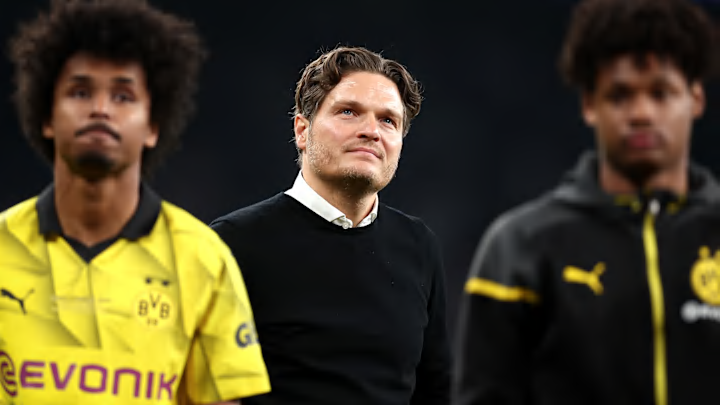High-stakes Bundesliga clashes, Klassiker duels, Ruhr derbies, and title deciders have all tested the limits of this club’s footballing DNA. These fixtures reveal more than results; they showcase how Dortmund’s managers have adapted to pressure, opposition, and expectation while staying true to the club’s attacking ethos.
This tactical review revisits decisive fixtures across three eras, analysing how Klopp, Tuchel, and Terzic approached moments that defined their tenures. Through victories, heartbreaks, and lessons learned, these matches chart the evolution of a club constantly balancing chaos and calculated order, forever chasing brilliance, and always unmistakably Borussia Dortmund.
Jurgen Klopp: The Birth of Relentless Football
Jürgen Klopp’s Borussia Dortmund didn’t just play football; they hunted. From 2010 to 2014, his high-intensity gegenpressing turned the Bundesliga on its head, suffocating opponents with relentless energy and lightning-fast transitions. Every high-stakes clash under Klopp carried the exact blueprint: press high, win the ball quickly, and strike before defenders could recover.
The 2012 DFB-Pokal Final, saw Bayern Munich dismantled 5-2 in a performance that epitomized the essence of gegenpressing. Lining up in a 4-2-3-1, Dortmund’s compact shape without the ball was pivotal, pressing triggers were perfectly timed as Gundogan and Bender hunted in midfield, forcing turnovers that led to rapid vertical attacks.
The front four: —Kagawa, Grobkreutz, Blaszczykowski, and Lewandowski — embodied Klopp’s mantra of “heavy metal football”. They transitioned from defence to attack in seconds, often bypassing Bayern’s midfield entirely. Kagawa’s movement between the lines disrupted Bayern’s structure, while Lewandowski’s finishing, particularly his hat-trick, punished every defensive lapse.

Full-backs Piszczek and Schmelzer balanced width with pressing angles, while Hummels’ progressive passing initiated attacks. The result was a masterclass in coordinated chaos, energy with intelligence.
This victory didn’t just secure a domestic double; it announced Dortmund as a tactical force in Europe. Klopp’s pressing game, once seen as reckless, was now blueprint-worthy. The 5-2 demolition remains one of the most complete expressions of his footballing philosophy: fearless, fluid, and ruthlessly effective.
Thomas Tuchel: Control, Precision and Positional Brilliance
Thomas Tuchel’s 2017 DFB-Pokal semi-final triumph over Bayern Munich was a tactical showcase of control through adaptability. Facing Carlo Ancelotti’s possession-heavy Bayern, Tuchel deployed a fluid 4-2-3-1 that morphed into a 5-4-1 out of possession, with the aim of neutralising Bayern’s width while retaining counter-attacking potential.

The wingbacks, Lukasz Piszczek and Erik Durm, were vital in compressing space on the flanks, forcing Bayern’s play centrally where Julian Weigl and Gonzalo Castro could intercept and recycle possession. Tuchel’s hallmark was precision, not chaos. Dortmund pressed selectively rather than relentlessly targeting Bayern’s build-up moments when Martinez or Alonso lingered on the ball.
In transition, the dynamism of Ousmane Dembele and Pierre-Emerick Aubameyang stretched Bayern’s high line. Dembele’s late winner, a curling strike from a devastating counter, encapsulated Tuchel’s game plan: lure Bayern forward, then punish them in open spaces with surgical precision.
Tuchel’s Dortmund combined blueprint discipline with technical flair, reflecting his philosophy of control through movement. Unlike Klopp’s intensity-driven frenzy, Tuchel’s structure was cerebral; every press, every pass had a purpose. This victory symbolised Dortmund’s evolution: still fearless, but now refined, calculated, and tactically mature.
Edin Terzic: Emotion, Adaptation, and the Modern Dortmund
Edin Terzic represents a bridge between Borussia Dortmund’s emotional past and its tactical present. A lifelong Dortmund fan turned coach, his approach blends the intensity of Klopp with the structure of Tuchel, passion guided by pragmatism. His most defining test came on the final day of the 2022-23 Bundesliga season, when Dortmund faced Mainz needing victory to secure their first title in over a decade.
Tactically, Terzic set up in a fluid 4-2-3-1, encouraging fullbacks to overload and midfielders to rotate aggressively between lines. The idea was to suffocate Mainz with width and tempo, but emotion overtook execution. Dortmund’s early defensive organisation and Mainz’s compact shape exposed their fragility under pressure. Yet even in heartbreak, the match reflected Terzic’s philosophy, an attacking system built on verticality, collective belief, and emotional connection with the crowd.
While the 2-2 draw cost Dortmund the title, it symbolised Terzic’s era: imperfect, yet profoundly human. He restored unity to a club that had lost its rhythm, prioritising identity over image. His Dortmund plays not for domination but for belonging, a team where tactics serve passion, not the other way round.
The Evolution of Dortmund’s Identity
Across three eras, Borussia Dortmund’s tactical identity has evolved without ever losing its essence. Under Jurgen Klopp, football was chaos, heavy-metal intensity powered by emotion and gegenpressing. His Dortmund thrived on energy, belief, and a shared sense of defiance. Thomas Tuchel brought modification to that raw aggression, introducing structure, balance, and possession-based control without sacrificing the club’s attacking DNA.

Then came Edin Terzic, the custodian of Dortmund’s spirit in a modern game obsessed with perfection. His system seeks stability between Klopp’s emotion and Tuchel’s intellect, pressing with purpose, attacking with quickness, but always connecting to the heart of the Yellow Wall.
Each coach left an imprint: Klopp built belief, Tuchel built systems, and Terzic rebuilt belonging. Through triumph and heartbreak, Dortmund’s tactical story is one of continuity through change, proof that identity in football isn’t fixed in shape or style, but in the values that guide both.
